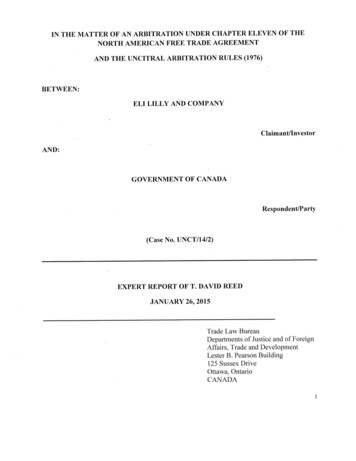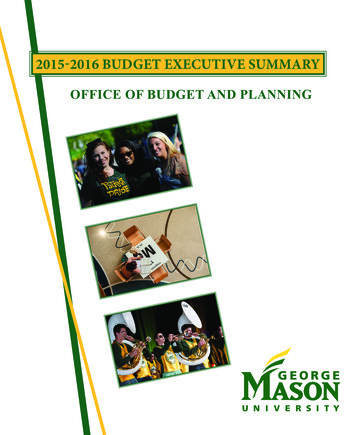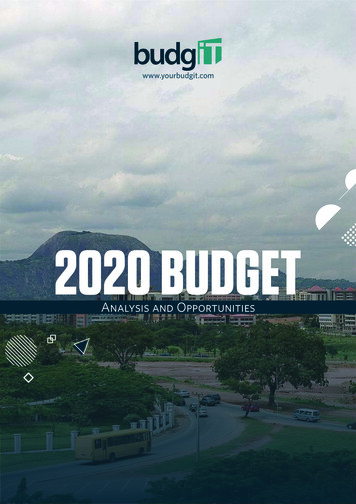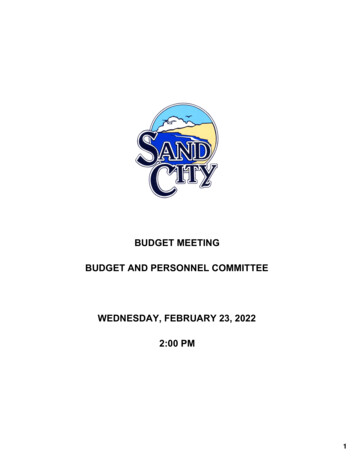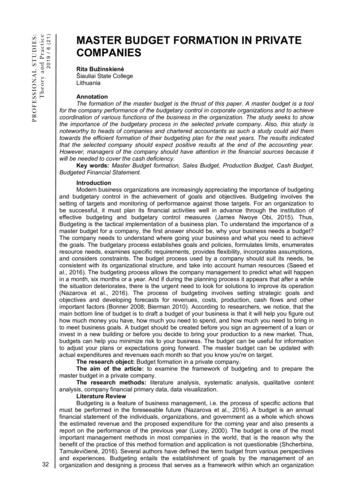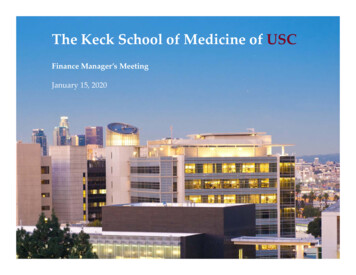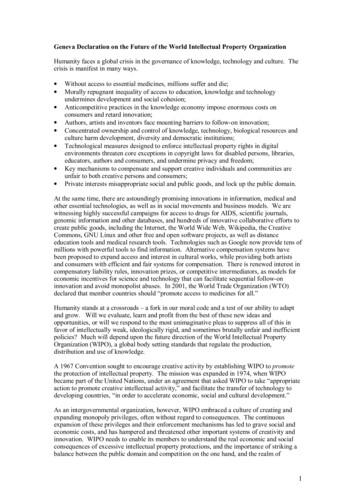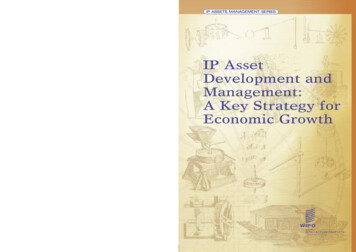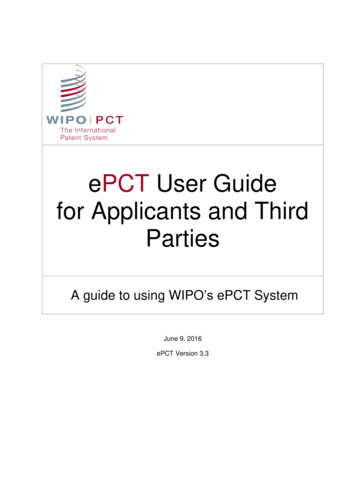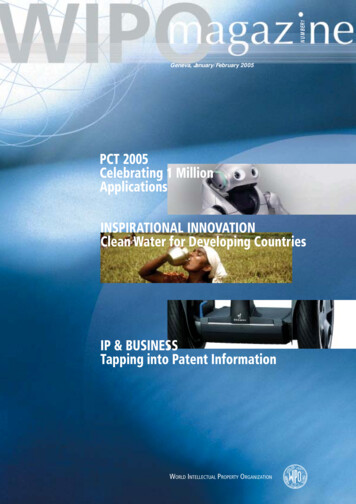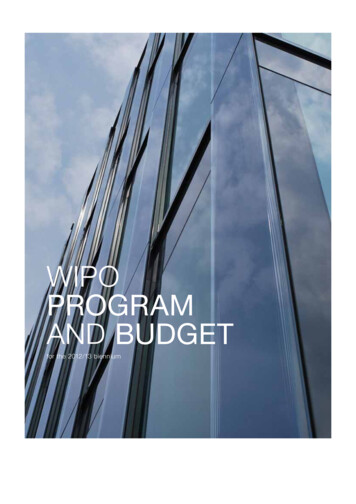
Transcription
WIPOPROGRAMAND BUDGETfor the 2012/13 biennium
PROGRAM AND BUDGET FOR THE 2012/13 BIENNIUMApproved by the Assemblies of the Member States of WIPO on September 29, 2011, subject to:“Efforts by the Secretariat to reduceexpenditure through cost efficiencymeasures by 10.2 million Swiss francs,from 647.4 million Swiss francs to637.2 million Swiss francs, through,inter alia, travel policies for staff and thirdparties, premises management, policiesfor payments of SSAs and honoraria forexperts and lecturers, internshipprograms, receptions and rental ofpremises and equipment duringconferences and a reduction of personnelcosts through improved organizationaldesign. These cost efficiency measureswill not affect Program delivery, resultsand targets as set out in the Program andBudget proposal. The Secretariat willreport back to Member States on theimplementation of the efficiencymeasures in the annual ProgramPerformance Reports;”** For complete text of the Assemblies’ decision see document A/49/18.
ii
Table of ContentsTABLE OF CONTENTSFOREWORD BY THE DIRECTOR GENERAL .5I.RESULTS OVERVIEW .8II.FINANCIAL OVERVIEW .13INCOME. 14EXPENDITURE. 17OVERALL EXPENDITURE . 17PERSONNEL EXPENDITURE . 19NON-PERSONNEL EXPENDITURE . 20DEVELOPMENT ACTIVITIES AND DEVELOPMENT AGENDA RESOURCES . 21III.PROGRAM NARRATIVES BY STRATEGIC GOAL.24STRATEGIC GOAL IProgram 1Program 2Program 3Program 4Patent Law. 27Trademarks, Industrial Designs and Geographical Indications. 31Copyright and Related Rights. 35Traditional Knowledge, Traditional Cultural Expressions and Genetic Resources. 41STRATEGIC GOAL IIProgram 5Program 6Program 31Program 7Program 10Program 11Program 30Provision of Premier Global IP Services . 45The PCT System . 48Madrid and Lisbon Systems . 53The Hague System . 58Arbitration, Mediation and Domain Names. 62STRATEGIC GOAL IIIProgram 8Program 9Balanced Evolution of the International Normative Framework for IP 25Facilitating the Use of IP for Development . 66Development Agenda Coordination. 70Africa, Arab, Asia and the Pacific, Latin America and the Caribbean Countries,Least Developed Countries . 74Cooperation with Certain Countries in Europe and Asia . 83The WIPO Academy. 87Small and Medium-Sized Enterprises (SMEs) and Innovation. 93STRATEGIC GOAL IV Coordination and Development of Global IP Infrastructure . 99Program 12Program 13Program 14Program 15International Classifications and Standards . 101Global Databases . 105Services for Access to Information and Knowledge . 109Business Solutions for IP Offices . 114STRATEGIC GOAL V World Reference Source for IP Information and Analysis . 118Program 16Economics and Statistics. 119STRATEGIC GOAL VIProgram 17International Cooperation on Building Respect for IP . 123Building Respect for IP . 124iii
Program and Budget for 2012/13STRATEGIC GOAL VIIProgram 18IP and Global Challenges. 129STRATEGIC GOAL VIIIProgram 19Program 20Addressing IP in Relation to Global Policy Issues . 128A Responsive Communications Interface Between WIPO, itsMembers and all Stakeholders . 134Communications . 135External Relations, Partnerships and External Offices. 139STRATEGIC GOAL IX Efficient Administrative and Financial Support . 144Program 21Program 22Program 23Program 24Program 25Program 26Program 27Program 28Program 29IV.ANNEXES.180ANNEX IANNEX IIANNEX IIIANNEX IVANNEX VANNEX VIANNEX VIIANNEX VIIIANNEX IXANNEX XV.Executive Management . 147Program and Resource Management . 152Human Resources Management and Development . 156General Support Services . 160Information and Communication Technology. 164Internal Oversight . 168Conference and Language Services . 171Safety and Security. 174Construction Projects . 1772012/13 BUDGET BY PROGRAM . 1812012/13 POSTS BY PROGRAM . 184ALLOCATION OF PROJECTED INCOME AND BUDGET BY UNION . 185EVOLUTION AND DEMAND FOR SERVICES UNDER THE PCT, MADRID ANDTHE HAGUE SYSTEMS IN THE MEDIUM TERM. 190FUNDS IN TRUST RESOURCES POTENTIALLY AVAILABLE FORPROGRAMMING. 201INDICATORS OF PCT OPERATIONS. 203WIPO ORGANIGRAM . 210ANNUAL BUDGET TABLES FOR IPSAS REPORTING . 2112012/13 BUDGET BY EXPECTED RESULT AND PROGRAM. 212DEVELOPMENT AGENDA LINKS FOR PROGRAM AND BUDGET 2012/13. 215APPENDICES.224APPENDIX AAPPENDIX BAPPENDIX CAPPENDIX DAPPENDIX EMEMBER STATES’ CONTRIBUTIONS . 225DEFINITION OF BUDGET HEADINGS . 229STANDARD COST FOR PERSONNEL. 231FLEXIBILITY FORMULAS . 232ACRONYMS AND ABBREVIATIONS USED IN THE PRESENTDOCUMENT . 233iv
Foreword by the Director GeneralFOREWORD BY THE DIRECTOR GENERALThe external environment has presented significant challenges for WIPO during the last two years. As aconsequence of the global economic crisis, the income of the Organization has fallen for the first time.While this fall in income has restricted possibilities for new initiatives, it has also presented an opportunityto introduce needed efficiencies and changes in procedures and processes within the Secretariat and inprogram delivery.I believe that we were able to make considerable progress in taking up that opportunity in the currentbiennium. In particular,-A series of cost-containment measures were implemented under a Crisis ManagementGroup that was established to monitor the financial performance of the Organization duringthe crisis. These measures enabled us to avoid reduction in service delivery despitereduced income.-The Strategic Realignment Program (SRP) moved from a phase of comprehensive designto deployment. It has introduced wide-ranging reforms across the Organization.-The long-term process of re-profiling the skill sets of staff to correspond to changing externalcircumstances is well under way. The new Senior Management Team of Deputy DirectorsGeneral and Assistant Directors General are in place. Key appointments have been madein the areas of Information and Communication Technology (ICT) (Chief InformationOfficer), Global Challenges, Human Resources, Economics and Statistics, Procurement,Ethics and Ombuds-function. A Voluntary Separation Program has been completed,reducing head count and opening up space for the regularization of long-servingshort-termers occupying continuing positions, as well as allowing for the introduction ofsome critically needed new skills.-A new performance management system has been fully deployed, with comprehensive stafftraining, a financial disclosure system adopted for senior managers and those in sensitivepositions, an ethics office has been established and an ethics code is under consultation.-An Information Technology (IT) strategy has been adopted and is being deployed, includingthe migration to an external provider of commodity services and the introduction of higherlevels of security, business continuity and disaster recovery.-The Organization has become International Public Sector Accounting Standards (IPSAS)compliant.-The new building has been completed and staff moved from rented premises into that newbuilding.These developments have created a solid foundation for building the results for the next two years.The next biennium is expected to see a welcome return to growth, with the Organization’s revenueestimated to grow by 4.7 per cent. This is cause for satisfaction, but two reservations need to beexpressed. First, the recovery remains somewhat fragile. We shall continue to monitor the financialperformance of the Organization with great vigilance and to publish quarterly financial results on our website for the benefit of the Member States. A second reservation concerns the cost structure of theOrganization. Staff costs account for 64 per cent of expenditure. Step increases, reclassifications andinflation will thus see a significant part of the overall increase in revenue absorbed by staff costs. Thisresult emphasizes the need, in the next several years, to examine judiciously the opportunities presentedby out-sourcing in selected areas. The speed of change in the external environment, which calls for theconstant renewal of skills, reinforces that need. We already rely heavily on out-sourcing in the areas ofPCT translation and IT. Other areas will be carefully and strategically reviewed to identify opportunitiesto reduce costs through operational efficiency or adjustment of the cost structure where possible.Several of these measures will take root during the course of the next biennium, providing us with theopportunity to monitor and report the results through the annual and biennial program performancereporting process. These improvements would then be baselined into the subsequent program andbudget proposals.In order to balance the 2012/13 budget proposal, no new posts or headcount will be added in the nextbiennium. Emphasis will instead be on the consolidation of human resources, managing performanceand alignment of the existing work force to organizational needs. In line with our commitment tolong-serving short-termers, the regularization of continuing short-term positions will be undertaken for5
Program and Budget for 2012/1360 posts in the next biennium (out of 156 approved in principle by Member States to be implementedover five years). Sixty-six continuing short-term positions are expected to have been regularized in thecurrent biennium through the filling of posts vacated as a result of the successful execution of theVoluntary Separation Plan.The proposal also contains within it a number of cost efficiency indicators across the administrative andsupport areas, as well as in areas of core operations such as PCT operations, where strategicinvestments in Information and Communication Technology (ICT) and customer facing systems arecontinuously improving productivity of our core operations. Pursuant to engaging discussions withMember States during the June 2011 informal Program and Budget Committee meeting, we arefurthering the work we undertook to review and revise the policy guidelines for staff and third party traveland will be in a position to share with Member States the potential savings and estimated efficiency gainsfrom such measures. Some of the detailed strategies and measures being considered are:-Further review and tightening of the travel policy and guidelines;-Stricter and more systematic enforcement of the guidelines by Senior Management Teammembers;-Improved planning discipline to ensure delayed booking costs are minimal or limited toexceptions;-Extension of the staff travel policy to third parties and financed participation of delegates;-Review and containment of hospitality costs; and-Increased use of videoconferencing and webcasting and the introduction of e-conferencesThe results-based planning approach applied to the preparation of the Program and Budget proposal forthe 2012/13 biennium has also yielded many positive results, including the identification of synergiesacross programs, the clarification of scope and boundaries of work where multiple programs contribute toa single result, greater clarity (and hence accountability) of the results framework and programperformance indicators, clear baselines and targets and, consequently, a much stronger basis forreporting to the Member States through the program performance reporting process.Theimplementation of major parts of the SRP in the next biennium is further expected to assist in containingexpenditure through greater efficiency in our business processes and better alignment of our programs,structure and resources to the Organization’s nine Strategic Goals.Development remains a priority in the 2012/113 biennium, reflected in an overall increase indevelopment expenditure from 19.4 per cent in the present 2010/11 biennium to 21.3 per cent in the nextbiennium. Consistently with the expressed wishes of Member States, development has beenmainstreamed. The Results Framework Chart identifies precisely where resources are devoted todevelopment across the various programs. Mainstreaming has brought about greater coherence in ourdevelopment activities and greater coordination between the Regional Bureaus and the substantiveprogram sectors. The Regional Bureaus, the Certain Countries in Europe and Asia and the LeastDeveloped Countries Divisions remain the focal points for the least developed and developing countriesand for countries with economies in transition. They keep the master plans for the activities proposedand conducted and the results to be achieved by the Organization in each country and are alsoparticularly responsible for national IP strategies and plans and capacity building. The substantive areasare responsible for delivery, within their areas of competence and always in cooperation with theRegional Bureaus, in accordance with the national IP strategies or country plans developed with eachcountry. Increased efforts will be made to move from an ad-hoc request-driven to a strategicdemand-driven planning approach.Other key outcomes that are foreseen for the new biennium include:-Increased geographical coverage and use of WIPO’s Global IP Systems (PCT, MadridSystem, Hague System, Lisbon System and the WIPO Arbitration and Mediation Center),the simplification of those systems and the continuous improvement and attractiveness ofthe systems through better IT services and tools and the amendment and updating ofrelevant regulations through the various working groups convened under the Assemblies ofthe relevant Unions.-The development of new norms and instruments in the international legal framework. It isalways difficult to suggest clear outcomes in the normative area, since they depend entirely6
Foreword by the Director Generalon the collective will of the Member States to reach shared positions. However, a number ofexercises are reaching a degree of technical maturity that now require only political will forcompletion. These include audiovisual performances, access to published works on thepart of the print disabled, broadcasters’ rights, traditional cultural expressions, traditionalknowledge and genetic resources, design formalities and the reform of the LisbonAgreement on the International Registration of Appellations of Origin.-The improvement of global IP infrastructure through the expansion of global IP informationdatabases, public-private cooperation in the availability of scientific and technical periodicalsand databases for the least developed and developing countries, the continueddevelopment of technical standards permitting enhanced inter-office cooperation, theestablishment or improvement of digital infrastructure in the offices of the least developedand developing countries, the delivery of knowledge-sharing platforms (such as WIPOCASE for the sharing of search and examination reports) and the establishment oftechnology and innovation support centers and transfer of technology offices in the leastdeveloped and developing countries.The draft Program and Budget reflects our determination to advance positive strategic change for theOrganization and to deliver the results that Member States and stakeholders expect. I would like tothank Member States for their input to and engagement with the process of developing the Program andBudget and for their ongoing contributions to the development of a shared vision of progress.Francis GurryDirector General7
Program and Budget for 2012/13I.RESULTS OVERVIEW1.This Program and Budget provides the planning for the biennium 2012/13 within the overallstrategic context of the Medium Term Strategic Plan (MTSP) and guided by the inputs received fromMember States.2.The current proposal ensures that the Organization’s resources are first deployed to theachievement of results that are of highest value to our Member States and stakeholders. In thiscontext, some of the highest priorities in the 2012/13 biennium are:(i)Ensuring a more widespread and better use of the services provided by WIPO’s globalregistration systems, in particular, the PCT, Madrid and The Hague, remains a key priority in2012/13 as a fundamental part of the services offered by the Organization and a mainfoundation for its long term financial sustainability. This will require meeting the challenges ofthe changing geographical composition of demand for such services including the adaption ofthe required language skills. Operational efficiency of the registration systems will also beenhanced by continuing to improve the electronic environment.(ii)Facilitating enhanced cooperation and greater consensus among Member States on thefurther development of a balanced international normative framework for IP will be a key focusin 2012/13: WIPO will aim at achieving progress in the development of a balanced internationallegal framework for trademarks, industrial designs and geographical indications,with outcomes at an appropriate normative level. Special emphasis will be placedon a future international regulatory framework for industrial design procedures,subject to sufficient progress being made at the preparatory level. Good progress is being made in the discussions on the protection of audiovisualperformances and broadcasting organizations in the Standing Committee onCopyright and Related Rights (SCCR). A recommendation has been made for theGeneral Assembly to decide on the reconvening of a Diplomatic Conference on theProtection of audiovisual performances. Limitations and exceptions to copyrightsand related rights also continue to be considered in the agenda of the Committeeand recent debate has focused on the needs for access to content in accessibleformats by persons with disabilities, particularly visually impaired persons, as wellas on the limitations and exceptions for libraries, archives and educational uses.The Secretariat will continue to facilitate discussions with a view to reaching aconsensus result. The Intergovernmental Committee on Intellectual Property and Genetic Resources,Traditional Knowledge and Folklore (IGC), at its 19th session in July 2011,recommended that the WIPO General Assembly in September 2011 renew itsmandate for the 2012/13 biennium. In terms of the proposed new mandate, theICG would be requested to submit to the 2012 General Assembly the text(s) of aninternational legal instrument(s) which will ensure the effective protection of geneticresources, traditional knowledge and traditional cultural expressions.The2012 General Assembly would “take stock of and consider the text(s), progressmade and decide on convening a Diplomatic Conference, and will consider theneed for additional meetings, taking account of the budgetary process”. Provision has been made for the possibility of diplomatic conferences shouldMember States decide to convene them in the biennium 2012/13.(iii) Increased efforts will be dedicated in the biennium 2012/13 to enhance access to, anduse of IP information and knowledge by IP institutions and the public to promote innovation andto enhance the access to protected creative works and creative works in the public domain.This will be achieved, firstly, by way of creating global IP infrastructure providing IP knowledgecontent, as public goods. This will be enhanced by global database initiatives such as8
Results OverviewPATENTSCOPE and GLOBAL BRAND DATABASE and continued exploration of the feasibilityof establishing international databases for creative works. Secondly, enhanced access to IPknowledge content will be facilitated through the creation of Technology Innovation SupportCenters (TISCs) and University Technology Transfer Offices (TTOs). Thirdly, the strengtheningof the technical infrastructure of IP offices, copyright offices and collective managementorganizations will facilitate an enhanced interaction between those offices/organizations and theprovision of more online services to all stakeholders.(iv) Enhancing human resource capacity in developing countries, LDCs and countries witheconomies in transition to effectively use IP for development, including by small andmedium-sized enterprises (SMEs), remains a substantial and cross-cutting strategy of most ofthe substantive Programs. Initiatives range from strengthening the human resources capacitiesof IP institutions to training in innovation commercialization, copyright, patent drafting, TK, TCEsand GRs and enforcement.(v)More effective communication to a broad public about IP and WIPO’s role is crucial toenable the Organization to optimize delivery of its mandate. Communication efforts will hencefocus on achieving greater visibility and wider recognition of WIPO’s role in encouraginginnovation and creativity; in facilitating multilateral dialogue on IP issues; and, as the primary,trusted provider of international IP expertise, information and services.(vi) Enhancing coordination and coherence within the Secretariat will continue through theStrategic Realignment Plan (SRP) to build a results-oriented, service-delivery and integratedadministration, with strengthened management accountability, a productive work environment,which reflects organizational values, and is supported by a fair and equitable regulatoryframework, respectful workplace policies and effective channels to address staff concerns.(vii) Enhanced efforts to provide effective and efficient and customer-oriented services toexternal stakeholders and internal clients will be pursued. The reform of human resourcemanagement policies and processes will contribute to the creation of a well managed,diversified, motivated and appropriately skilled workforce and an improved workingenvironment. Enabling culture change through a focus on performance, both at the individualand organizational level, will build on progress made in the biennium 2010/11. Theimplementation of the Information and Communication Technology (ICT) strategy and enhancedICT governance will focus on realizing business benefits from ICT investments that are closelyaligned to strategic priorities.3.Development remains a priority in the biennium 2012/13 in line with the MTSP and MemberStates’ expectations. This is reflected by an increase in development expenditure in the next biennium(Results Framework Chart and Table 9). One of the main objectives of the 2012/13 planning processhas been the mainstreaming of development across all substantive Strategic Goals and all relevantPrograms of the Organization in line with the Development Agenda (DA) recommendations (ResultsFramework Chart: see development share budget by result). This has resulted in the mainstreamingof WIPO’s activities related to a) national IP regulatory frameworks that promote creativity andinnovation and reflect the level of development of the different WIPO Member States; and b) thestrengthening of the institutional and technical infrastructure of IP institutions into the substantiveStrategic Goals I and IV, respectively, and the relevant substantive Programs 1, 2, 14 and 15. Thismainstreaming is expected to improve the Organization’s delivery of development oriented activities todeveloping countries, LDCs and countries with economies in transition in terms of effectiveness,efficiency, better coordination and coherence with an ultimate higher development impact. Thedelivery model is based on substantive sectors providing the substantial and technical expertise forthe implementation of development activities. The Regional Bureaus and the Certain Countries inEurope and Asia and LDCs Divisions are to be the custodians of planning and programming at thenational level, in close cooperation with all countries concerned, and responsible for the overallcoordination of activities at the country level. In addition, the strategy for delivering developmentactivities will shift from a request driven to a more strategic and needs driven approach articulated incountry plans.4.The Development Agenda recommendations continue to guide WIPO activities. Programlinkages to the DA recommendations have been substantively reflected in each relevant programnarrative. DA projects have been mainstreamed, both in terms of substance and resources, in eachprogram. Linkages are provided to the organizational expected results in line with the Budgetary9
Program and Budget for 2012/13Process for Projects Proposed by the Committee on Development and Intellectual Property (CDIP) forthe Implementation of the DA Recommendations approved by the WIPO Assemblies in 2010 1 .Applying a consistent project management and review methodology to DA projects will continue toensure that lessons from the projects are adequately learned before embarking on subsequent projectphases, subject to the approval of the CDIP, or mainstreaming project activities into the regular workof the Organization.5.The mainstreaming of development, including DA projects, is illustrated in the ResultsFramework Chart, by Strategic Goal III “Facilitating the use of IP for Development” being both a“vertical” and a “horizontal” Goal. The development share of the budget by result (Results FrameworkChart) clearly delineates the proportion of each expected result which is development oriented anddirectly benefits developing countries, LDCs and countries with economies in transition. Expenditureis defined as development expenditure only where the beneficiary is a developing country and theequivalent expenditure is not available for developed countries. The next biennium will see anincrease in the overall share of development expenditure (excluding DA projects) from 19.4 per cent in2010/11 to 21.7 per cent in 2012/13, representing an increase of 17 per cent in development2expenditure while overall expenditure increase has been contained at 4.7 per cent.6.WIPO’s support for the Millennium Development Goals (MDGs) is undertaken within theframework of the nine
Officer), Global Challenges, Human Resources, Economics and Statistics, Procurement, Ethics and Ombuds-function. A Voluntary Separation Program has been completed,
